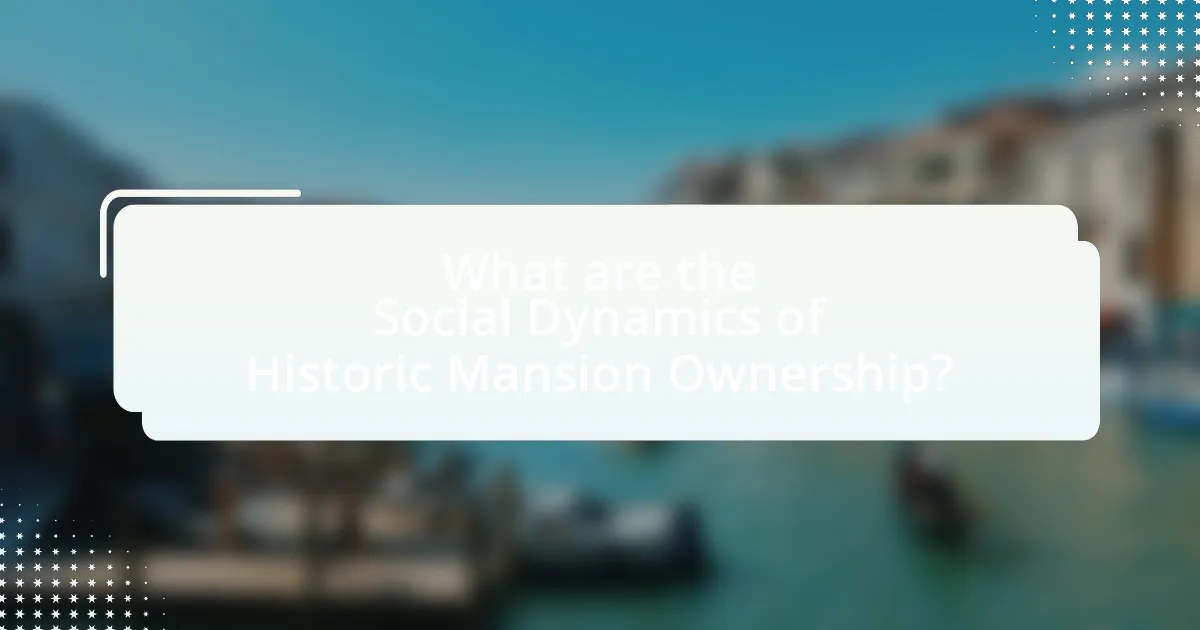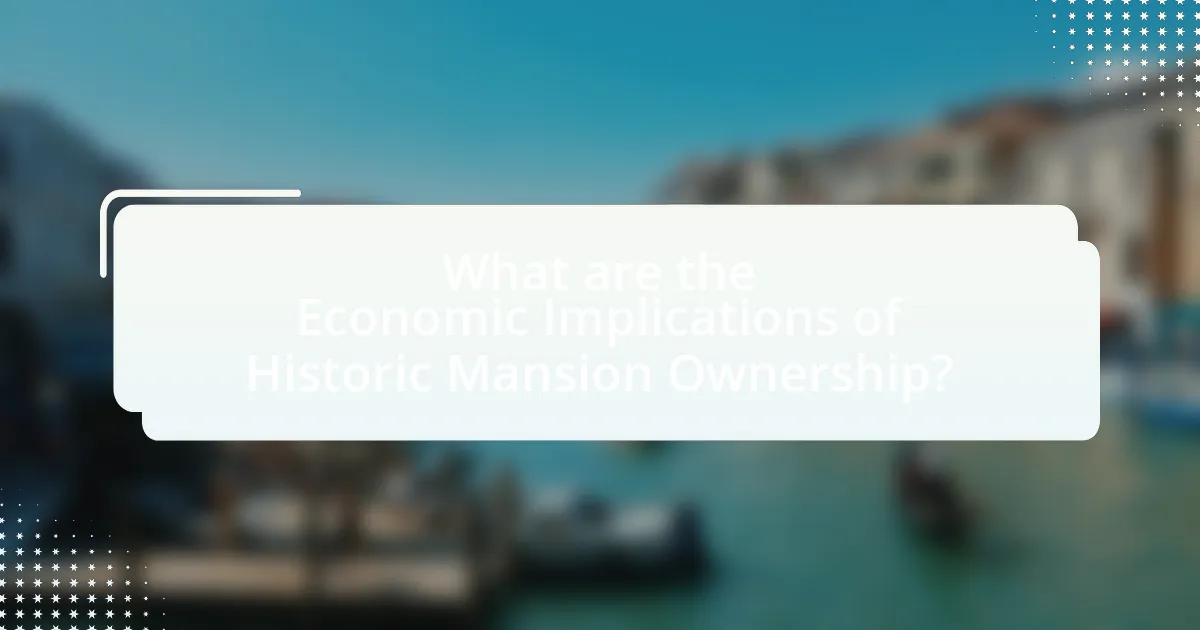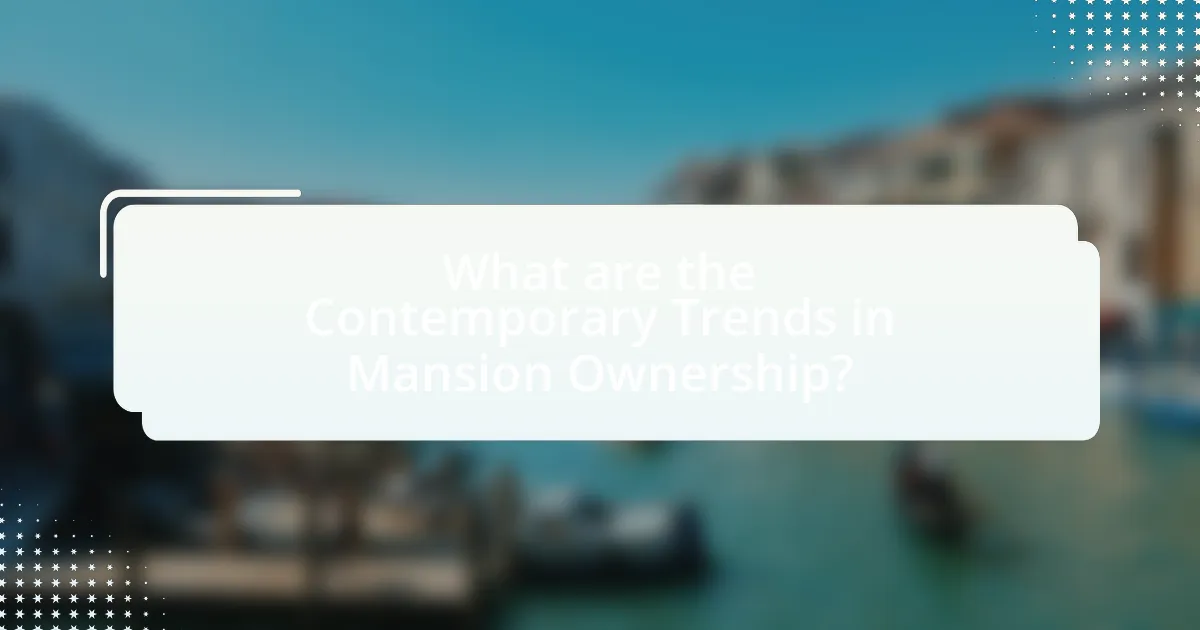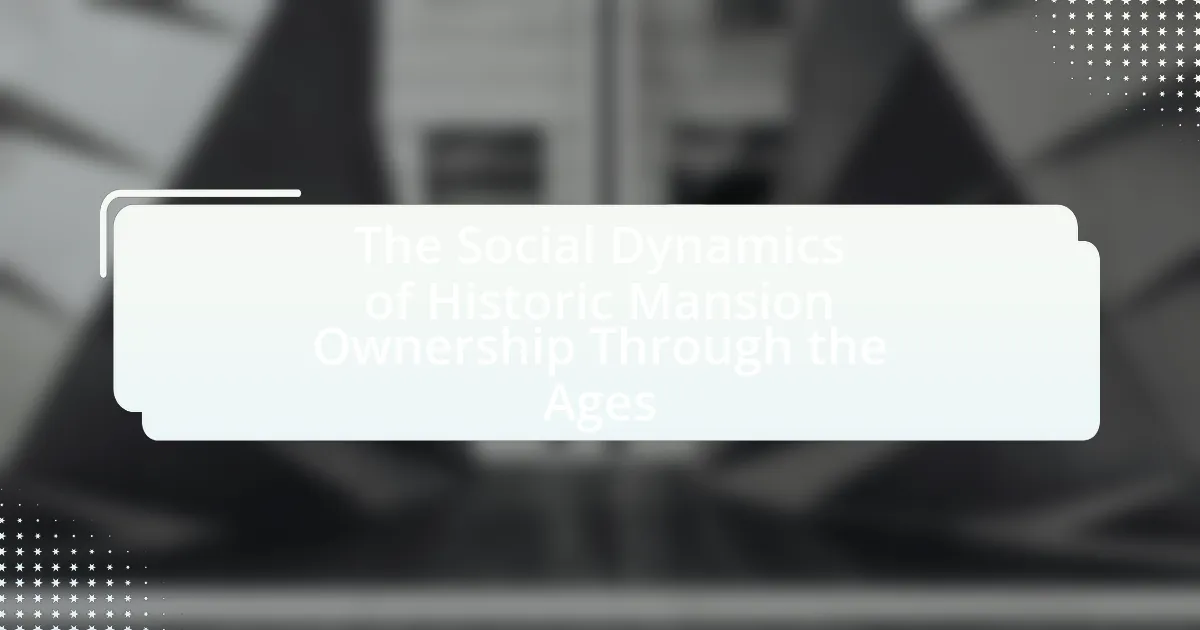The article examines the social dynamics of historic mansion ownership, highlighting the interplay of status, heritage, and community engagement throughout history. It explores how mansion ownership has evolved from the medieval era, where it symbolized power among the nobility, to contemporary trends emphasizing sustainability and technology. Key factors influencing ownership, such as social class, cultural values, and economic implications, are discussed, along with the responsibilities of modern owners in preserving cultural heritage and contributing to community development. The article also addresses the financial aspects of maintaining historic properties and the innovative uses of mansions in today’s society.

What are the Social Dynamics of Historic Mansion Ownership?
The social dynamics of historic mansion ownership involve the interplay of status, heritage, and community engagement. Owners of historic mansions often occupy a unique social position, as these properties symbolize wealth and historical significance, influencing their interactions within elite social circles. For instance, the ownership of a historic mansion can enhance an individual’s social capital, allowing them to participate in exclusive events and networks that reinforce their status. Additionally, these owners frequently engage in preservation efforts, which can foster community relationships and contribute to local cultural heritage, as seen in initiatives like the National Trust for Historic Preservation in the United States. This dual role of historic mansion owners as both custodians of heritage and active community members illustrates the complex social dynamics at play.
How has mansion ownership evolved over different historical periods?
Mansion ownership has evolved significantly from feudal times to the modern era, reflecting changes in social structures, economic conditions, and cultural values. In the medieval period, mansions were primarily owned by nobility and served as symbols of power and status, often built for defense and showcasing wealth. During the Renaissance, the rise of merchant classes led to increased ownership among wealthy traders, who constructed grand homes to display their affluence and cultural sophistication. The 18th and 19th centuries saw the emergence of the industrial revolution, which democratized mansion ownership as the new wealthy class, including industrialists and entrepreneurs, began to acquire large estates. In the 20th century, mansion ownership became more accessible to the upper middle class, with suburbanization and the development of luxury housing markets. Today, mansions are often seen as luxury real estate investments, with ownership increasingly characterized by global wealth and the influence of international buyers. This evolution illustrates the shifting dynamics of wealth, class, and cultural significance associated with mansion ownership throughout history.
What factors influenced mansion ownership in the medieval era?
Mansion ownership in the medieval era was primarily influenced by social status, wealth, and political power. Nobility and wealthy landowners acquired mansions as symbols of their status and as centers for governance and social gatherings. The feudal system dictated land ownership, where lords granted land to vassals in exchange for military service, thus reinforcing the connection between land ownership and power. Additionally, the Church played a significant role, as ecclesiastical leaders often owned large estates, further intertwining religious authority with land ownership. Historical records indicate that the construction of grand estates was often a reflection of the owner’s influence and resources, with many mansions serving as both residences and administrative hubs during this period.
How did the Renaissance change the perception of mansion ownership?
The Renaissance significantly transformed the perception of mansion ownership by elevating it from mere shelter to a symbol of cultural and intellectual prestige. During this period, the revival of classical learning and the arts led wealthy individuals to invest in grand residences that reflected their status and appreciation for beauty, knowledge, and humanism. This shift is evidenced by the construction of elaborate palaces and villas, such as the Palazzo Medici in Florence, which showcased not only wealth but also a commitment to art and scholarship, thereby redefining mansions as centers of social and cultural life rather than just private homes.
What role do social class and status play in mansion ownership?
Social class and status significantly influence mansion ownership, as these properties often serve as symbols of wealth and social standing. Historically, individuals from higher social classes, such as aristocrats or affluent business magnates, have been the primary owners of mansions, reflecting their economic power and societal influence. For instance, during the Gilded Age in the United States, wealthy industrialists constructed grand estates to showcase their success and establish their place in high society. This trend continues today, where ownership of mansions is often associated with elite social circles, reinforcing the connection between property ownership and social hierarchy.
How does ownership of a mansion reflect social hierarchy?
Ownership of a mansion signifies a high social status and reflects social hierarchy by demonstrating wealth, power, and exclusivity. Historically, mansions have been associated with affluent families and elite social classes, serving as symbols of economic resources and social influence. For instance, during the Gilded Age in the United States, the construction of grand mansions by industrialists illustrated their newfound wealth and positioned them above the working class and middle class in societal rankings. Additionally, the architectural styles and locations of these mansions often reinforced social stratification, as they were typically situated in affluent neighborhoods, further distinguishing their owners from lower socioeconomic groups.
What are the implications of mansion ownership for social mobility?
Mansion ownership significantly restricts social mobility by reinforcing wealth disparities and limiting access to resources for lower socioeconomic groups. The concentration of wealth in mansions often leads to the establishment of exclusive communities, which can create barriers for individuals from less affluent backgrounds to enter these spaces. Historical data indicates that areas with high concentrations of mansions often correlate with lower rates of upward mobility; for instance, research from the Equality of Opportunity Project shows that neighborhoods with affluent residents tend to have less economic mobility for their lower-income counterparts. This dynamic perpetuates a cycle where wealth is inherited and maintained within a select group, further entrenching social stratification.
How do cultural factors impact mansion ownership?
Cultural factors significantly impact mansion ownership by influencing societal values, economic status, and property aesthetics. For instance, in cultures that prioritize status and wealth, owning a mansion is often seen as a symbol of success, leading to higher demand for such properties. Additionally, cultural heritage can dictate architectural styles and preferences, affecting the types of mansions that are built and maintained. Historical data shows that in regions like Europe, where aristocratic lineage is valued, mansions are often preserved as family estates, reflecting cultural traditions of inheritance and legacy. In contrast, in rapidly urbanizing cultures, such as in parts of Asia, modern interpretations of mansion ownership may focus on luxury and contemporary design, shifting the traditional views of what constitutes a mansion.
What cultural values are associated with historic mansions?
Historic mansions are associated with cultural values such as heritage, status, and craftsmanship. These values reflect the historical significance of the mansions as symbols of wealth and power, often built by influential families or individuals. For instance, many historic mansions feature architectural styles that represent the artistic movements of their time, showcasing the craftsmanship and design principles that were valued in society. Additionally, these structures often serve as cultural landmarks, preserving the history and traditions of the communities in which they are located, thereby reinforcing a sense of identity and continuity.
How do regional differences affect mansion ownership dynamics?
Regional differences significantly influence mansion ownership dynamics by affecting property values, cultural significance, and market demand. For instance, in regions with a rich historical context, such as New England, mansions often command higher prices due to their architectural heritage and historical importance, leading to a competitive market among affluent buyers. Conversely, in areas with less historical significance, such as certain parts of the Midwest, mansion ownership may be less sought after, resulting in lower property values and a different demographic of buyers. Additionally, local economic conditions, tax regulations, and zoning laws further shape the dynamics of mansion ownership, as seen in states like California, where high demand and restrictive land use policies drive up prices and limit availability.

What are the Economic Implications of Historic Mansion Ownership?
Historic mansion ownership has significant economic implications, including property value appreciation, tourism revenue generation, and maintenance costs. Owners of historic mansions often experience increased property values due to their unique architectural features and historical significance, which can lead to higher resale prices. For example, properties listed on the National Register of Historic Places can see value increases of 10% to 20% compared to non-historic properties.
Additionally, historic mansions can attract tourism, contributing to local economies through visitor spending on accommodations, dining, and attractions. In regions where historic mansions are open to the public, such as in Charleston, South Carolina, tourism can account for a substantial portion of local revenue.
However, ownership also entails significant maintenance costs, as historic properties often require specialized restoration and upkeep to preserve their integrity. According to the National Trust for Historic Preservation, the average cost of maintaining a historic home can be 20% to 30% higher than that of a modern home due to the need for specialized materials and craftsmanship.
In summary, while historic mansion ownership can enhance property values and stimulate local economies through tourism, it also imposes higher maintenance costs that owners must consider.
How does mansion ownership contribute to local economies?
Mansion ownership contributes to local economies by generating significant revenue through property taxes, tourism, and local business support. High-value properties like mansions often lead to increased tax revenues for municipalities, which can be used for public services and infrastructure. Additionally, mansions frequently attract tourists, leading to increased spending in local hotels, restaurants, and shops. For example, historic mansions that are open for tours can draw thousands of visitors annually, as seen with properties like the Biltmore Estate in North Carolina, which contributes millions to the local economy each year. Furthermore, the maintenance and restoration of these properties create jobs and stimulate demand for local contractors and artisans, further enhancing economic activity in the area.
What are the financial responsibilities of owning a historic mansion?
Owning a historic mansion entails significant financial responsibilities, including maintenance, insurance, property taxes, and potential restoration costs. Maintenance is crucial as historic properties often require specialized care to preserve their architectural integrity, which can be more expensive than standard home upkeep. Insurance premiums for historic mansions are typically higher due to their value and the risk of damage to unique features. Property taxes may also be elevated, reflecting the mansion’s historical significance and market value. Additionally, owners may face substantial costs for restoration projects to comply with preservation standards, which can be mandated by local or national heritage organizations. These financial obligations underscore the complexity and commitment involved in owning a historic mansion.
How do historic mansions influence property values in their areas?
Historic mansions positively influence property values in their areas by enhancing the overall desirability and aesthetic appeal of the neighborhood. The presence of these architectural landmarks often attracts higher-income buyers and investors, leading to increased demand for nearby properties. For instance, a study by the National Trust for Historic Preservation found that homes located within historic districts can sell for 20% to 30% more than similar homes outside these areas, demonstrating a clear correlation between historic mansions and elevated property values. Additionally, the preservation of historic mansions often leads to improved local amenities and infrastructure, further boosting property values in the vicinity.
What are the costs and benefits of maintaining a historic mansion?
Maintaining a historic mansion incurs significant costs and offers various benefits. The costs include ongoing expenses for restoration, preservation, and compliance with historical regulations, which can reach hundreds of thousands of dollars annually. For example, the National Trust for Historic Preservation estimates that maintaining historic properties often requires specialized materials and skilled labor, leading to higher maintenance costs compared to modern homes.
On the other hand, the benefits of maintaining a historic mansion include cultural heritage preservation, potential tax incentives, and increased property value. Historic mansions often attract tourism, generating revenue for local economies. According to the National Park Service, historic preservation can enhance community identity and pride, contributing to social cohesion. Thus, while the financial burden is substantial, the cultural and economic advantages can be significant.
What are the common challenges faced by mansion owners?
Mansion owners commonly face challenges such as high maintenance costs, property taxes, and regulatory compliance. The upkeep of large estates often requires significant financial investment, with estimates indicating that maintenance can range from 1% to 3% of the property’s value annually. Additionally, mansion owners frequently encounter substantial property tax bills, which can be exacerbated by the historical significance of the property, leading to higher assessments. Regulatory compliance, including zoning laws and preservation guidelines, can also pose difficulties, as owners must navigate complex legal frameworks to maintain their properties. These challenges highlight the multifaceted responsibilities associated with owning a mansion.
How can owners maximize the value of their historic properties?
Owners can maximize the value of their historic properties by investing in restoration and preservation efforts that maintain the property’s architectural integrity. Properly restoring historic features, such as original woodwork, windows, and roofing, can significantly enhance market value, as evidenced by studies showing that well-preserved historic homes can sell for 20% to 30% more than comparable non-historic properties. Additionally, obtaining historic designations can provide tax incentives and grants, further increasing financial viability. Engaging with local historical societies and participating in heritage tourism initiatives can also elevate the property’s profile, attracting potential buyers and investors interested in historic real estate.

What are the Contemporary Trends in Mansion Ownership?
Contemporary trends in mansion ownership include a shift towards sustainable living, increased interest in smart home technology, and a growing preference for multi-functional spaces. Owners are increasingly prioritizing eco-friendly features, such as solar panels and energy-efficient systems, reflecting a broader societal focus on environmental responsibility. Additionally, the integration of smart home technology allows for enhanced security and convenience, appealing to tech-savvy buyers. The trend towards multi-functional spaces caters to the need for versatility in living arrangements, accommodating remote work and leisure activities within the same environment. These trends are supported by market research indicating that luxury homebuyers are willing to invest in properties that align with their values and lifestyle preferences.
How are modern owners redefining mansion ownership?
Modern owners are redefining mansion ownership by prioritizing sustainability, technology integration, and multifunctional spaces. This shift reflects a growing awareness of environmental impact, with many owners opting for eco-friendly materials and energy-efficient systems, such as solar panels and smart home technology. For instance, a report from the National Association of Realtors indicates that 66% of homebuyers consider energy efficiency important, influencing mansion renovations and new constructions. Additionally, modern mansions often feature adaptable spaces that can serve multiple purposes, catering to changing lifestyles and remote work trends. This evolution in ownership not only enhances the living experience but also aligns with contemporary values of sustainability and flexibility.
What innovative uses are being found for historic mansions today?
Historic mansions are increasingly being repurposed as boutique hotels, event venues, and cultural centers. These innovative uses allow for the preservation of architectural heritage while generating revenue and community engagement. For instance, many historic mansions have been transformed into luxury accommodations that attract tourists, thereby contributing to local economies. Additionally, some mansions serve as venues for weddings and corporate events, capitalizing on their unique aesthetics and historical significance. Cultural centers within these properties often host art exhibitions, educational programs, and community gatherings, fostering a connection between the past and present. This trend not only preserves the structures but also revitalizes interest in local history and culture.
How is sustainability influencing mansion renovations?
Sustainability is significantly influencing mansion renovations by prioritizing energy efficiency, eco-friendly materials, and sustainable practices. Homeowners are increasingly opting for renovations that incorporate renewable energy sources, such as solar panels, which can reduce energy costs and carbon footprints. Additionally, the use of reclaimed materials and sustainable building practices not only preserves the historical integrity of the mansion but also minimizes environmental impact. For instance, a study by the National Trust for Historic Preservation found that energy-efficient upgrades can lead to a 30% reduction in energy consumption in historic homes. This shift towards sustainability reflects a broader societal trend where the preservation of heritage aligns with environmental responsibility.
What are the social responsibilities of current mansion owners?
Current mansion owners have social responsibilities that include preserving cultural heritage, contributing to community development, and promoting environmental sustainability. By maintaining historic properties, owners help to protect architectural history and cultural narratives, which can enhance local tourism and education. Additionally, mansion owners can engage in philanthropy, supporting local charities and initiatives that benefit the community, thereby fostering social cohesion. Furthermore, they should implement sustainable practices, such as energy-efficient renovations and land conservation, to minimize their environmental impact. These responsibilities are crucial as they ensure that mansion ownership contributes positively to society and the environment.
How can mansion owners contribute to community development?
Mansion owners can contribute to community development by utilizing their properties for public events, educational programs, and cultural initiatives. By hosting community gatherings, art exhibitions, or historical tours, mansion owners can foster local engagement and promote cultural heritage. For instance, many historic mansions have been transformed into museums or community centers, which not only preserve history but also provide educational resources and job opportunities for local residents. This approach has been validated by studies showing that community-focused initiatives can enhance social cohesion and economic growth, as seen in the revitalization efforts in areas surrounding historic properties.
What role do historic mansions play in cultural preservation today?
Historic mansions serve as vital repositories of cultural heritage, preserving architectural styles, historical narratives, and community identities. These structures often reflect the social, economic, and artistic values of their time, providing insight into past lifestyles and societal norms. For instance, the preservation of mansions like the Mount Vernon estate in Virginia not only maintains George Washington’s legacy but also educates the public about 18th-century American life. Furthermore, historic mansions frequently host cultural events, educational programs, and tours, actively engaging communities and fostering a sense of belonging. This engagement is supported by organizations such as the National Trust for Historic Preservation, which emphasizes the importance of preserving these sites for future generations.
What practical tips can potential mansion owners consider?
Potential mansion owners should conduct thorough research on the property’s historical significance and maintenance requirements. Understanding the historical context can enhance the value and appreciation of the mansion, as properties with rich histories often attract more interest and investment. Additionally, maintaining a mansion can be costly; for instance, older homes may require specialized restoration techniques to preserve their architectural integrity, which can be significantly more expensive than standard home repairs. Engaging with local preservation societies can provide valuable resources and guidance on best practices for upkeep and restoration, ensuring that the mansion remains both a personal residence and a piece of history.

Leave a Reply